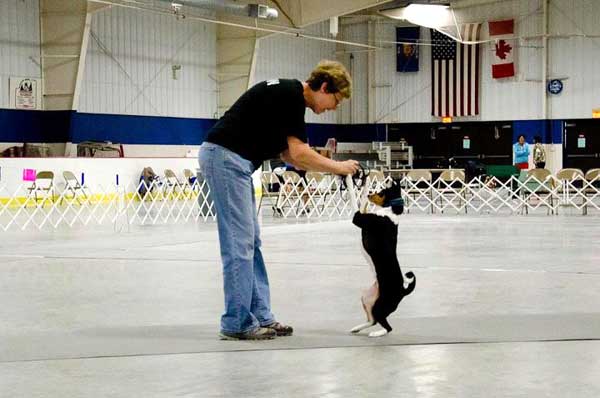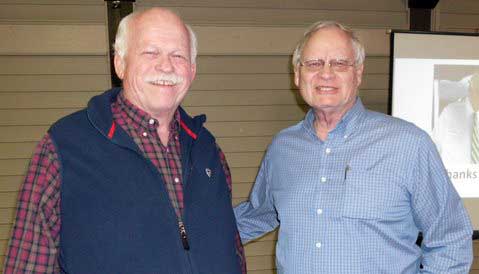Pages 7 & 8 <previous page> <next page>
Mutation responsible for Fanconi Syndrome in basenjis found.

Miranda was given a moment in the ring before Best of Breed judging (at the BCOA Nationals)
to be recognized for her unique contribution and to honor all the dogs
who contributed to this great discovery. (Lisa Marshall & Miranda, Bunyard photo)
from OFA:
New DNA test for Fanconi syndrome in Basenjis. Dr. Gary Johnson at the University of Missouri has identified the mutation responsible for recessive basenji Fanconi Syndrome. This test is the result of eighteen years researching many pedigrees, candidate genes and the collection of thousands of blood samples. A new test, a direct Fanconi gene test is now available through the OFA https://secure.offa.org/cart.html .
The procedure for ordering the test and collecting saliva for application to the FTA card has not changed from that of the linkage test.
PLEASE NOTE that there are two order carts on the OFA website for Fanconi testing, one for new, or first, tests labeled "Fanconi DNA" at $65 and the second, labeled "Facnoni retest", only for use with dogs previously tested with the linkage test, at $50. Be sure the registration number, name and birth date on the retest order matches that on the original linkage test certificate. The cost of retesting is being subsidized by the Basenji Health Endowment.
Upon completion of the online order for the Fanconi Retest of a dog that was previously tested with the linkage marker test, the lab will check the storage facility for existing DNA. If enough DNA remains a new FTA card will not be required. The test will be performed from the existing sample, whether from blood or FTA card. A new kit will be mailed where DNA quantities are insufficient.
Certificates will be sent to the owner, and results displayed on the OFA website. Test result descriptions for the new direct test will not contain the word "Probably" and there will be no "indeterminate" results.
Jon Curby, OFA
Here is the link to the slides and notes from Dr. Johnson's presentation at Nationals that are presently on the BCOA website: <https://www.basenji.org/ClubDocs/Johnson_2011_Presentation.pdf>![]()
Report from the 2011 BCOA National Specialty:
The Direct Genetic Test for Fanconi Syndrome!/Kirsten S Sigrist
It was a great honor to be present at this year’s BCOA National Specialty on the heels of Dr Johnson’s exciting news that he had found the mutation responsible for Fanconi Syndrome in basenjis and had replaced the marker test with a new direct genetic test!
The room at the show site was filled with cheers for Dr Johnson and a standing ovation as he began his presentation. There were more than 50 slides covering all aspects of his research into the genetics of Fanconi Syndrome. Dr Johnson generously provided copies of these slides for publication on the BCOA website, where everyone will have an opportunity to learn from them. I was impressed with the clarity of his presentation. I think every basenji fancier should take the time to look at the presentation once it has been posted.
Of course, everyone was excited to hear how the discovery was made. Early this year Dr Johnson sequenced the whole genome of CH Arendahl’s Carnival Night (Miranda). This sequence was compared to that of a boxer, published in 2004. When Dr Johnson looked at the differences between the two sequences, he was unable to find anything of interest. However, due to the nature of the sequencing technology, there were gaps in the basenji sequence. These gaps are usually in G-C rich regions of the genome. One such gap was not in a G-C rich region. When Dr Johnson investigated this anomalous gap, he realized that there was a 370 base pair deletion in the basenji genome and was able to confirm that this deletion, within a previously unsuspected gene, was the cause of Fanconi Syndrome in basenjis! He confirmed this by retesting the samples of 70 affected dogs. To the best of his knowledge, this will have been the first time that a canine disease gene was found through full genome sequencing; a historic milestone!
This discovery is of monumental importance to the basenji community and I am sure the BCOA Health and Research Committee will announce its own guidelines for retesting and breeding dogs. In the meantime, I can only report what was presented by Dr Johnson. Within his presentation, he explained in detail the shortcomings of the marker test, which has been in use since 2007. He showed an example of how a probable clear x probable clear mating could produce a probable carrier and expressed his personal opinion that any breeding animal, including probable clears should be retested. He feels it is extremely unlikely that any dog that tested probably clear will retest as anything other than clear or carrier, so retesting probable clears that are pets should be unnecessary. As the retesting is done in the next year or two, we will learn a lot about the accuracy of the marker test. Dr Johnson feels that the marker test helped to reduce the incidence of Fanconi Syndrome since its introduction and probably had an accuracy of greater than 90%, but could not give a figure until more retesting is done. He clearly stated that no breeding dog should be considered “clear by parentage” based on results from the marker test.
Jon Curby announced that the BHE has agreed to supplement the cost of retesting dogs. Any dog that was previously tested using the marker test can be retested at a discounted rate of $50/ test. This discount will only be available once the OFA makes the retest option available on its website (November 1st at the latest) and then will only be available for a limited time (probably 1-2 years). If there is sufficient DNA stored, the retest will be done on the stored sample. If there is not a large enough sample, the owner will be mailed a sample collection card after they have placed and paid for the order.
Dr Johnson is very excited by this finding and is hoping to get support from BCOA to explore the functional significance of this very large deletion and perhaps find reasons why not all of the basenjis which tested probably affected using the marker test became ill. He thinks this research could also help develop more effective treatments for Fanconi Syndrome. He is looking forward to working with the club on whatever inherited disease is our next highest priority, probably PRA.
There were many moving moments throughout the weekend. Dr Johnson and Jon Curby both received standing ovations during and at the close of the presentation. 
Jon Curby & Dr. Gary Johnson (photo by Jo Thompson)
At the banquet Beth Straub made a moving introduction of Dr Johnson, asking all those who had lived with a Fanconi dog to raise their hands, followed by a short presentation of an engraved clock and a champagne toast. Miranda was given a moment in the ring before Best of Breed judging to be recognized for her unique contribution and to honor all the dogs who contributed to this great discovery. (Lisa Marshall & Miranda – photo by Clayton Bunyard) – video on the rvw facebook page.